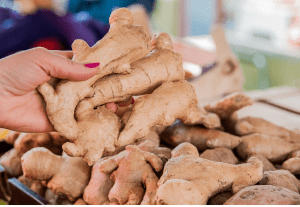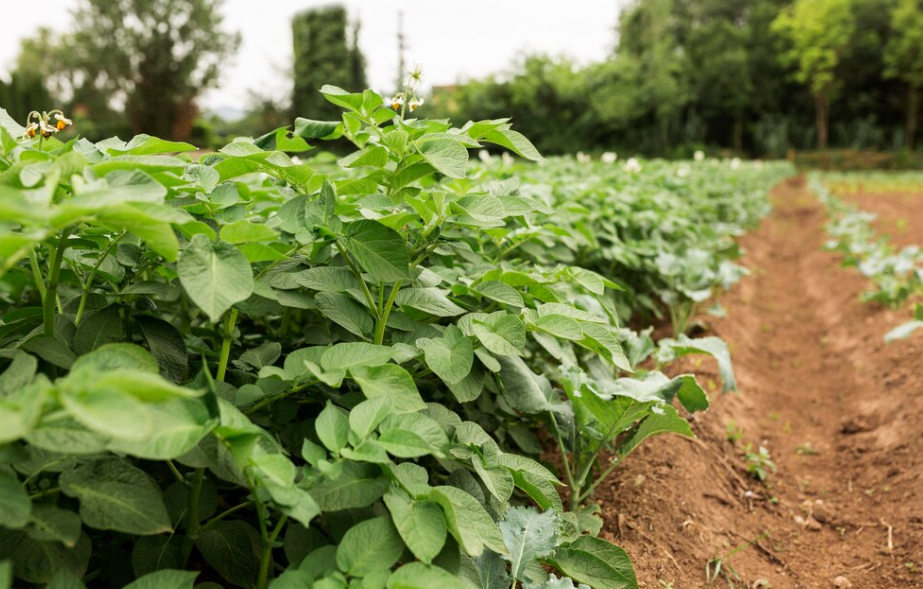Origin
With the botanical name Zingiber officinale, ginger is an herbaceous perennial plant of the family Zingiberaceae, probably native to southeastern Asia, its aromatic, pungent rhizome (underground stem) is used as a spice, flavoring, food, and medicine.
Ginger is propagated by its rootstalk cuttings; you can also plant it by dividing the roots of a crowded colony or by moving an already existing plant to a new area. Gingers do not grow in the wild; it is commonly planted from their rootstalk.
Their leafy stems that grow to a meter high, and the leaves are 15 to 30 cm (6 to 12 inches) long, opposite in two vertical rows; their stems are wrapped in a sheath from which the leaves arise.
They are used in pastries for flavor and in cooking soup and stews; they are also used as ingredients in bread, sauces, curry dishes, confections, ginger ale, and pickles.
Nutrient Composition
This is a spice containing a fair amount of nutrients and is found essential for many different purposes. Listed below are the nutrients found in 100 grams of ginger:
- Calories 80
- Total Fat 0.8 g
- Sodium 13 mg
- Potassium 415 mg
- Total Carbohydrate 18 g
- Dietary fiber 2 g
- Sugar 1.7 g
- Protein 1.8 g
Preferred Botanical Name: Zingiber officinale
Preferred Common Name: Ginger
Local Common Name;
- Yoruba: Atale
Medicinal Properties And Uses
Ginger has been found to be useful in the human body. It helps in maintaining good and healthy living. Some of the uses of ginger are listed below:
- This is a popular spice. It contains gingerol in high amounts, which is a potent anti-inflammatory.
- Just 1–1.5 grams of ginger can prevent nausea such as seasickness, chemotherapy-related nausea, morning sickness, and nausea after surgery.
- Muscle pain and exercise-induced muscle soreness can be reduced by eating ginger.
- Eating ginger reduces common health problems such as osteoarthritis.
- They have been shown to lower blood sugar levels and improve various heart disease risk factors in patients with type 2 diabetes.
- There are beneficial to people with indigestion and stomach-related discomfort because it speeds up the emptying of the stomach.
- Talking ginger at the beginning of the menstrual period is very effective against menstrual pain.
- They also help protect against age-related damage to the brain. Aged women have improved brain function from eating ginger.
- They help fight harmful bacteria and the RSV virus, which could reduce your risk of infections.
How To Grow Ginger
Yield Information
Under the right conditions, ginger growth may occur within eight to ten months after planting. You can start to harvest the roots after a few months, but it’s best to leave them for their maximum growth time for the best results. The primary shoot and root systems are the major growth components.
Under normal weather conditions, the primary shoots grow at 1 to 1.5 cm a day. The average yield of ginger is 6-10 tonnes/acre.
Nursery And Transplant Requirements
You can grow ginger from the rhizomes or enlarged roots. Properly transplanting the plant is important so that the plant will continue to grow. The steps to proper transplanting include:
- If you are transplanting to a new bed, use a spading fork to loosen the soil around the ginger plant, then lift the ginger rhizomes out of the ground.
- Your ginger bed should be partially or fully shaded. Mix a 2-inch layer of compost with the soil to a depth of 6 inches.
- Plant the ginger rhizomes at a 1-inch depth and 15 inches apart. Ensure that the buds on the rhizome are facing upward.
- Ensure that the plants have sufficient water up to 6 inches after transplanting. To prevent moisture loss, apply a 1 to 2 inches layer of mulch on the bed.
- They requires lots of water while growing; do not allow the soil to dry out.
Soil And Sun Requirements
An ideal soil for growing ginger is loose, loamy, and rich in organic matter. Loamy soils allow water to drain freely, which will help prevent the rhizomes from becoming waterlogged. Thick mulch can also provide nutrients, retain moisture, and help control weeds.
Mildly acidic soil is suitable for planting ginger for healthy growth and rhizome production. Your soil ph should be between 5.5 and 6.5. High soil pH indicates alkalinity, while too low indicates acidity, and it can distort the ginger growth process.
Apply compost manure to the soil to lower its pH or calcium carbonate or dolomite to increase the pH. High organic content in the soil provides ginger with the nutrients it requires to yield healthy rhizomes.
Moist and well-draining soil is optimal for this plants. The soil mixture must hold moisture; however, ginger plants must not be exposed to overly saturated or waterlogged soil. Ginger requires 2-5 hours of direct sunlight for proper growth and maximum yield.
Watering Requirements
Ginger requires deep watering at least once every week. Ensure that plants do not dry out during the active growing stage and reduce watering during cool weather to encourage the plants to form underground rhizomes. In dry regions, frequently spray or mist plants.
Planting And Spacing Requirements
Their rhizomes are cut into 1 to 1 1⁄2 inch pieces and are set aside for a few days so that the cut surface can heal and form a callus before planting. Ensure that each part of the ginger is plump with well-formed growth buds. Plant each piece with the growth bud pointing upward.
The rhizomes are planted 6 to 8 inches apart and 2 to 4 inches deep. You plant the rhizomes whole or in smaller pieces with one or two growing buds.
Harvesting Of Ginger
Mature ginger rhizomes will generally be ready to be harvested in about 10-12 months or after the leaves die back. You can decide to harvest the entire plant or remain some so the plant can continue to grow when harvesting.
The rhizomes will have firmer skin that will bruise less easily when handling and washing. Harvest them by digging the entire plant and then sorting the rhizomes for replanting.
Storage Of Ginger/Ginger Rhizomes
Do not store sliced or peeled ginger at room temperature. Ginger lasts longer when refrigerated, say up to 3 weeks, as long as it is not exposed to air and moisture. Without peeling, you can store ginger at room temperature in an environment free from moisture to prevent growth and disease infestation.
Diseases And Pests
Bacterial Wilt
Bacteria cause this, and its symptoms include infected leaves getting curled, leaves turning yellow and necrotic, plants becoming stunted and dying, and rhizomes being discolored and water-soaked.
You can manage naturally by planting ginger in well-drained soils where ginger had not been previously grown, planting disease-free varieties, plant them on hills to aid soil drainage, and promoting airflow around the rhizomes.
Rhizome rot
Oomycetes cause rhizome rot and cause plants stunted growth, yellow leaves and stems, brown discoloration of water-conducting tissues within the branch, and foul odor from rotten rhizomes.
You can manage traditionally by planting rhizomes in hills to allow for good drainage, do not plant seeds that show rot symptoms, treat seed pieces with hot water, and destroy all crop debris after harvest.
Chinese rose beetle
These insects cause holes in leaves and consume the entire leaves except the veins. The adult insects feed on the plant at night. You can control it by shining bright light on plants; this helps deter insects as they are repelled by bright light, covering young plants with floating row covers.
Root-Knot Nematode
A nematode causes it, and this causes water-soaked lesions on roots, yellow leaves with fewer shoots, and stunted growth. You can control culturally by planting resistant varieties and treating rhizomes with hot water before planting.
Conclusion
Ginger is a dynamic spice praised for its diverse applications in both cooking and healing. Bursting with essential bioactive components, ginger possesses extraordinary anti-inflammatory and antioxidant capabilities, promoting a state of optimal health. Its innate ability to ease nausea makes it a highly sought-after solution for combating motion sickness, morning sickness, and nausea caused by chemotherapy. Not only that, but ginger has also shown promise in improving digestion by speeding up stomach emptying and providing relief from indigestion.
Moreover, it may have a positive effect on blood sugar levels, making it a valuable addition to any wellness routine, it is also a powerful ally for individuals living with diabetes. Its immune-boosting properties make it an excellent defense against infections. Not only that, but its anti-inflammatory benefits can also alleviate symptoms of osteoarthritis, bringing relief to those struggling with joint discomfort. By incorporating ginger into your diet, you can take a holistic approach to maintaining your health.

